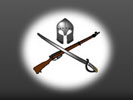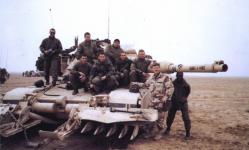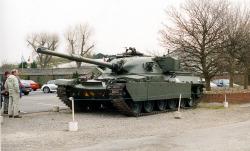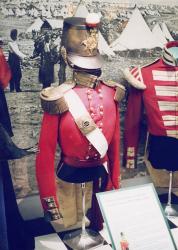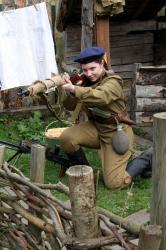Translate this Page
Battles of Aroji and Magdala
Battle Name : Battles of Aroji and Magdala
Date(s) : 10 April 1868 - 13 April 1868
Part of : British Victorian Colonial 'Small Wars' , Magdala Campaign ,
Outcome : A victory for British and Indian Forces over Abyssinian Tribal levies
Type of battle : Land
Summary
Battles fought after 7 month build up and nearly three month approach march of about 400 miles. Battle at Aroji resulted in British losses of 2 dead and 18 wounded. Abyssinian losses at least 700 dead and 1,500 wounded . Storming of Magdala saw award of 2 Victoria Crosses. British Artillery moved by elephant. Naval Rocket Brigade included in the Force.
Location
SE of Lake Tana Abyssinia (East Africa)
More details
The expedition was mounted to recover hostages held by the Abyssinians. The build up after landing at Annesley Bay S of Massawa included the building of 14 miles of railway.
Napier was aware that the Expeditionary Force should complete its work before the onset of the hot weather. At Antelo he decided to split his force sending a light Division on ahead with the main force some two days march behind. The latter was required to secure the route for the return march. The pace quickened but there was much dissension over the shedding of baggage – so much so that the 33rd Foot (Duke of Wellingtons Regt) lost its place at the head of the column and was moved to the rear. The final approach to Magdala offered two routes. The first, and apparently easiest via the Aroji Ravine was so fraught with danger if defended that Napier taking the advice of the Reconnaissance Party opted for the second and moved by the Gambaji and Afijo Plateaux. Some twelve miles from Magdala and within site of the objective Napier came across the track cut by Theodore in moving his artillery. Theodore had reached Magdala some ten days previously on the 27th March. The Battle of Aroji, on the 10th April was unintended and nearly a disaster for Napier. The Baggage train hearing that it was undefended took the Aroji Ravine route and arrived on the Aroji Plateau between the two opposing forces. Theodore despatched about 3,500 of his 5,000 man force to round up Napier’s Baggage Train. Quickly realising his predicament Napier ordered the 4th Foot (Kings Own Regiment) and the 23rd Bengal Native Infantry Regt (Punjab Pioneers) forward in the face of enemy canon and a steadily advancing infantry. Fortunately the Naval Rocket Brigade, with the Baggage Party, was quickly on the scene and in action. Their rockets whilst not causing many casualties inspired the Abyssinians to pause and the British with their new Snider rifles took a great toll of the attackers and scattered them. An attempt to outflank the baggage train was stopped by a workmanlike bayonet charge by the 23rd Bengal Native Infantry which decimated the attackers. By the time the Mountain battery had opened up the Abyssinians withdrew leaving about 700 dead on the field but taking their wounded with them. On the day following the battle Theodore released all the hostagesand also sent many cattle and much grain to Napier as a peace offering. This was however rejected as Napier realised that, without the death or capture of Theodore, his return to the coast would have to be fought every step of the way. On 13th April at 9.am with the 33rd Foot leading the final assault was launched on the Magdala massif. The Selassi and Salamji plateaux were cleared and at 4.pm after an hours bombardment the 33rd together with Royal Engineers and Indian Sappers arrived at the Kokit Bir Gate. Because of a great pile of rocks behind the gate it was impossible to clear and a search was made for alternative entry points. A weak spot was found and Pte James Ergin and Drummer Michael Magner obtained a foothold on the wall which was quickly exploited. Both were later awarded the Victoria Cross With Regimental Colours flying (Darrell Bates says the last time Colours were carried into battle) the 33rd were soon on to the summit. There it was found that Theodore had committed suicide by shooting himself rather than facing capture. After a period of looting the Expeditionary Force, with many difficulties made its way back to the coast arriving at Annesly Bay on 10th June.
First time breech loading rifles used by British Forces. First time Khaki drill used in place of red coats. 8 war correspondents (including H.M. Stanley and G.A Henty) two foreign observers and RGS and British Museum Reps included in Force. Pictures mainly from London Illustrated News and other details to be found on website:http://www.britishempire.co.uk/forces/armycampaigns/africancampaigns/campabyssinia.htm Bibliography includes: Bates, Sir Darrell, “The Abyssinian Difficulty,” OUP, 1979 Henty,G.A. et al, “Battles of the Nineteenth Century – Vol1”, Cassel and Co. London 1896. Hernon, Ian, “Massacre and Retribution – Forgotten Wars of the Nineteenth Century,” Sutton Publishing 1998, ISBN 0-7059-1846-2 (Magdala)
